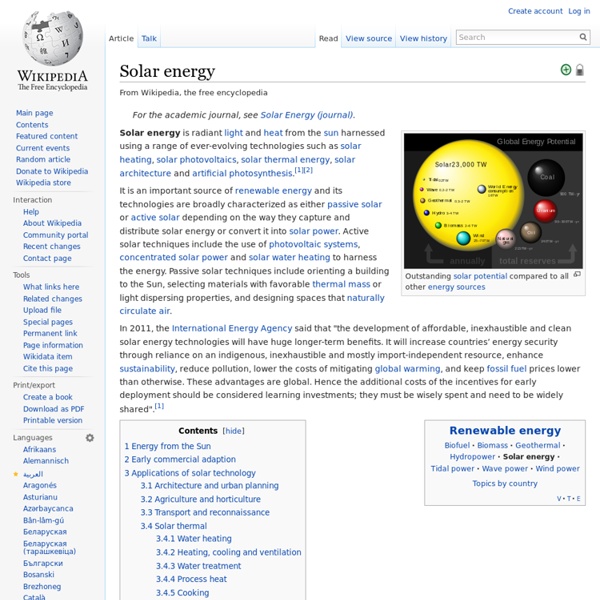Minister says solar farms are 'a blight on the landscape'
18 October 2014Last updated at 21:10 ET The environment secretary described large-scale solar farms as "ugly" Environment Secretary Liz Truss has said large-scale solar farms are "a blight on the landscape" and confirmed plans to cut a taxpayer subsidy to farmers and landowners for the schemes. She told the Mail on Sunday the land could be better used for growing food.
Solar Power Information and Facts
Solar energy is the technology used to harness the sun's energy and make it useable. As of 2011, the technology produced less than one tenth of one percent of global energy demand. Many are familiar with so-called photovoltaic cells, or solar panels, found on things like spacecraft, rooftops, and handheld calculators. The cells are made of semiconductor materials like those found in computer chips. When sunlight hits the cells, it knocks electrons loose from their atoms. As the electrons flow through the cell, they generate electricity.
Solar power
Average insolation showing land area (small black dots) required to replace the world primary energy supply with solar electricity (18 TW or 568 Exajoule, EJ, per year). Insolation for most people is from 150 to 300 W/m2 or 3.5 to 7.0 kWh/(m2day). The first three units of Solnova in the foreground, with the two towers of the PS10 and PS20 solar power stations in the background.
What is Renewable Energy? Sources of Renewable Energy.
What is renewable energy? Energy exists freely in nature. Some of them exist infinitely (never run out, called RENEWABLE), the rest have finite amounts (they took millions of years to form, and will run out one day, called NON-RENEWABLE) With this in mind, it is a lot easier to lay any type of energy source in its right place. Let's look at these types of energy in the diagram below:
Solar Energy Generating Systems
"SEGS" redirects here. For the airport with that ICAO code, see Seymour Airport. Solar Energy Generating Systems (SEGS) in California, with the combined capacity from three separate locations at 354 megawatts (MW, 474,700 hp), is now the world's second largest solar thermal energy generating facility, after the commissioning of the even larger Ivanpah facility in 2014.
Solar energy as Renewable and alternative energy, Solar ...
The Earth receives an incredible supply of solar energy. The sun, an average star, is a fusion reactor that has been burning over 4 billion years. It provides enough energy in one minute to supply the world's energy needs for one year.
Solar Photovoltaic Technology Basics
Solar cells, also called photovoltaic (PV) cells by scientists, convert sunlight directly into electricity. PV gets its name from the process of converting light (photons) to electricity (voltage), which is called the PV effect. The PV effect was discovered in 1954, when scientists at Bell Telephone discovered that silicon (an element found in sand) created an electric charge when exposed to sunlight.
Renewable Energy
Cutting Pollution, Creating Opportunity St. Lawrence-Franklin D. Roosevelt Power Project - hydroelectric generating facility on the St.
Obama plan gives 'hope' for Paris deal - BBC News
The UK government has welcomed President Obama's plan to cut greenhouse gases and boost clean power. A spokeswoman for the UK Department of Energy and Climate Change (Decc) said it would lift chances of a global deal at a Paris climate summit in December. When asked if the US had now overtaken Europe in its ambition on climate she declined to comment.
Time to shine: Solar power is fastest-growing source of new energy
Solar power was the fastest-growing source of new energy worldwide last year, outstripping the growth in all other forms of power generation for the first time and leading experts to hail a “new era”. Renewable energy accounted for two-thirds of new power added to the world’s grids in 2016, the International Energy Agency said, but the group found solar was the technology that shone brightest. New solar capacity even overtook the net growth in coal, previously the biggest new source of power generation. The shift was driven by falling prices and government policies, particularly in China, which accounted for almost half the solar panels installed.



